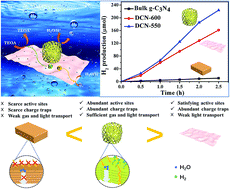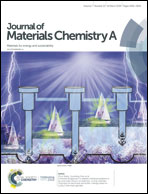Template-free synthesis of nanocage-like g-C3N4 with high surface area and nitrogen defects for enhanced photocatalytic H2 activity†
Abstract
Nanocage-like 3D porous graphitic carbon nitride (g-C3N4) with a high surface area and nitrogen defects was successfully prepared via a novel, template-free, cost-effective and hydrothermal-copolymerization route. Compared with pristine g-C3N4, the synergetic effect of nitrogen vacancies combined with a nanocage-like structure endowed it with a broad visible-light-responsive range, more exposed active lateral edges and catalytically active sites, as well as efficient separation of photogenerated carriers. As a consequence, the modified g-C3N4 exhibited prominent photocatalytic performance in water splitting for the hydrogen evolution reaction under visible light illumination. The optimized photocatalyst (DCN-550) showed a maximum photocatalytic H2 evolution rate of 92.57 μmol h−1, almost 20.3 times higher than that of pristine g-C3N4. Moreover, a possible mechanism for the photocatalytic hydrogen evolution and nanostructure formation process based on the experimental results was proposed. The new growth strategy developed here could inspire similar attempts to modify novel visible-light-driven photocatalysts through nanostructure design.



 Please wait while we load your content...
Please wait while we load your content...